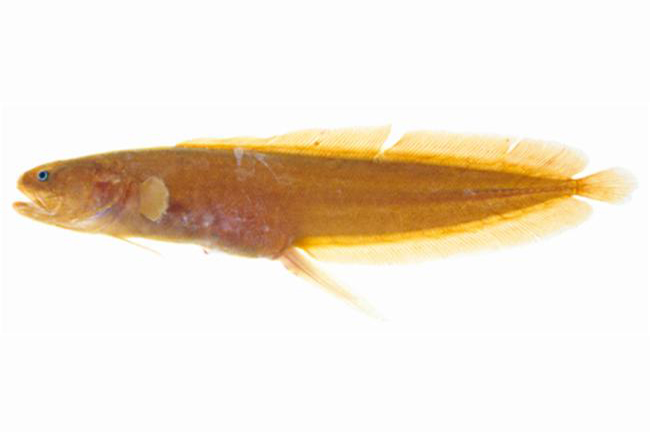Littoral Cusk, Monothrix polylepis Ogilby 1897

Littoral Cusk, Monothrix polylepis. Source: Barry Hutchins / Western Australian Museum. License: All rights reserved
Summary:
A small yellow, orange or brown cusk with long-based dorsal and anal fins separated from the caudal fin, and the head naked except for a patch of scales on the cheek.
Cite this page as:
Bray, D.J. 2021, Monothrix polylepis in Fishes of Australia, accessed 03 Jul 2025, https://fishesofaustralia.net.au/home/species/4069
Littoral Cusk, Monothrix polylepis Ogilby 1897
More Info
|
Distribution |
Endemic to south-eastern Australia from Cook Island, northern New South Wales, to Port Phillip, Victoria. Shelters in caves and crevices on coastal reefs in depths to 15 m. |
|
Features |
Dorsal fin 93-104; Anal fin 64-76; Vertebrae 45-47, precaudal vertebrae 13-14; Branchiostegal rays 6-7. Predorsal length short, 26.5-30.7% SL; Anterior nostril low on snout; copulatory organ of male with a simple and small flap-like pair of (outer) pseudoclaspers; scale patch only on cheek, head otherwise naked; upper preopercular pore present; opening of first and second lower preopercular pores joined; maxilla expanded posteroventrally; anterior anal fin pterygiophore short. |
|
Remarks |
Records of this species from South Australia are actually specimens of the Southern Pygmy Blindfish, Dactylosurculus gomoni. |
|
Species Citation |
Monothrix polylepis Ogilby 1897, Proceedings of the Linnean Society of New South Wales 22(1): 88. Type locality: Maroubra, 33°57'S, 151°16'E, Sydney, New South Wales. |
|
Author |
Bray, D.J. 2021 |
|
Resources |
Littoral Cusk, Monothrix polylepis Ogilby 1897
References
Cohen, D.M. & Nielsen, J.G. 1978. Guide to the identification of genera of the fish order Ophidiiformes with a tentative classification of the order. National Marine Fisheries Service (U.S.) Technical Report 417: 1-72 figs 1-103
Gomon, M.F. 2008. Family Bythitidae. pp. 356-359 in Gomon, M.F., Bray, D.J. & Kuiter, R.H. (eds). Fishes of Australia's Southern Coast. Sydney : Reed New Holland 928 pp.
Knudsen, S.W., Møller, P.R., Schwarzhans, W, & Nielsen, J.G. 2016. Molecular, morphological and fossil input data for inferring relationship among viviparous brotulas (Bythitidae) – Resulting in a family status change for Dinematichthyidae. 8: 461-464 https://doi.org/10.1016/j.dib.2016.05.055
Kuiter, R.H. 1993. Coastal Fishes of South-eastern Australia. Bathurst : Crawford House Press 437 pp.
Møller, P. R., Knudsen, W., Schwarzhans, W. & Nielsen, J.G. 2016. A new classification of viviparous brotulas (Bythitidae) – with family status for Dinematichthyidae – based on molecular, morphological and fossil data. Molecular Phylogenetics and Evolution 100: 391-408. https://doi.org/10.1016/j.ympev.2016.04.008
Nielsen, J.G., Cohen, D.M., Markle, D.F. & Robins, C.R. 1999. Ophidiiform Fishes of the World. An annotated and illustrated catalogue of pearlfishes, cusk-eels, brotulas and other ophidiiform species known to date. FAO Fisheries Synopsis No. 125 Vol. 18. 178 pp.
Nielsen. J.G. 1999. Families Carapidae, Ophidiidae, Bythitidae, Aphionidae. pp. 1978-1985 in Carpenter, K.E. & Niem, V.H. (eds). The Living Marine Resources of the Western Central Pacific. FAO Species Identification Guide for Fisheries Purposes. Rome : FAO Vol. 3 pp. 1397-2068.
Ogilby, J.D. 1897. New genera and species of Australian fishes. Proceedings of the Linnean Society of New South Wales 22(1): 62-95 See ref at BHL
Schwarzhans, W. & Møller, P.R. 2007. Review of the Dinematichthyini (Teleostei: Bythitidae) of the Indo-west Pacific. Part III. Beaglichthys, Brosmolus, Monothrix and eight new genera with description of 20 new species. The Beagle, Records of the Museums and Art Galleries of the Northern Territory 23: 29-110



